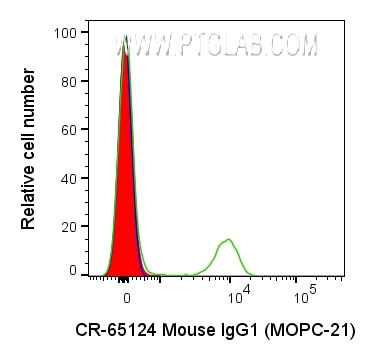Validation Data Gallery
Filter:
Tested Applications
| Positive FC detected in |
Recommended dilution
| Application | Dilution |
|---|---|
| This reagent has been tested for flow cytometric analysis. It is recommended that this reagent should be titrated in each testing system to obtain optimal results. | |
| Sample-dependent, Check data in validation data gallery. | |
Product Information
CR-65124 targets IgG1 Isotype Control in FC applications and shows reactivity with n/a samples.
| Tested Reactivity | n/a |
| Host / Isotype | Mouse / IgG1, kappa |
| Class | Monoclonal |
| Type | Antibody |
| Immunogen | N/A 相同性解析による交差性が予測される生物種 |
| Full Name | immunoglobulin heavy constant gamma 1 (G1m marker) |
| Gene Symbol | IgG1 Isotype Control |
| Gene ID (NCBI) | 16017 |
| RRID | AB_3084953 |
| Conjugate | Cardinal Red™ Fluorescent Dye |
| Excitation/Emission maxima wavelengths | 592 nm / 611 nm |
| Form | Liquid |
| Purification Method | Affinity purification |
| UNIPROT ID | P01868 |
| Storage Buffer | PBS with 0.09% sodium azide and 0.5% BSA , pH 7.3 |
| Storage Conditions | Store at 2-8°C. Avoid exposure to light. Stable for one year after shipment. |
Background Information
The MOPC-21 immunoglobulin is useful as an isotype-matched control. The MOPC-21 immunoglobulin has an unknown binding specificity and is used as an isotype control for mouse IgG1 antibodies. This antibody has been quality-tested for flow cytometry as negative control.
Protocols
| Product Specific Protocols | |
|---|---|
| FC protocol for Cardinal Red™ IgG1 Isotype Control antibody CR-65124 | Download protocol |
| Standard Protocols | |
|---|---|
| Click here to view our Standard Protocols |
